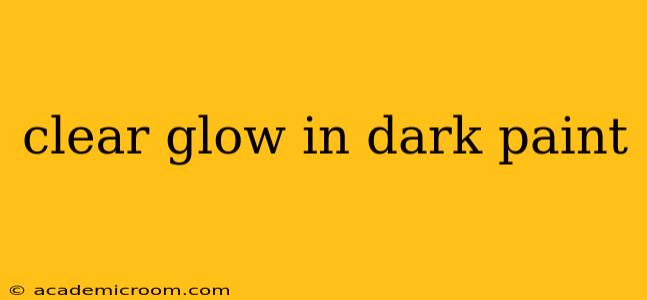Glow-in-the-dark paint has come a long way. No longer relegated to childish novelty items, it's now used in everything from safety markings to artistic creations. But achieving a truly clear glow is a challenge. This guide will explore the nuances of finding and using clear glow-in-the-dark paint, addressing common questions and offering expert advice.
What Makes Glow-in-the-Dark Paint Glow?
Glow-in-the-dark, or phosphorescent, paint contains phosphors – materials that absorb energy (usually light) and then slowly release it as light over time. The clearer the paint, the less pigment obscuring the phosphors, leading to a brighter, more noticeable glow. However, achieving true transparency while maintaining a strong glow is tricky.
What are the Different Types of Glow-in-the-Dark Paint?
Several types of glow paint exist, each with varying levels of clarity and glow duration:
-
Acrylic-based: These are water-based and easy to clean up, making them popular for artists. Clear acrylic glow-in-the-dark options are available, although the clarity might compromise the glow intensity.
-
Solvent-based: Offering brighter and longer-lasting glows, solvent-based paints are typically less user-friendly due to strong fumes and cleanup requirements. Finding truly clear versions can be more challenging.
-
Epoxy-based: These are durable and weather-resistant, often used for outdoor applications. They typically aren't marketed as "clear," but some formulations might offer a relatively transparent effect.
The choice depends on your needs and the application. For a clear glow, acrylic might be a starting point, but expect some compromise in glow intensity.
How Can I Make My Glow-in-the-Dark Paint More Clear?
While there isn't a magic formula to instantly create perfectly clear glow-in-the-dark paint, several techniques can help:
-
Using a clear base: Mix your glow powder (available separately) with a clear resin or acrylic medium. This allows for greater control over the final product's transparency. Experimentation is key to finding the right ratio of powder to medium for your desired effect.
-
Multiple thin coats: Instead of applying one thick coat, several thin coats of glow paint will allow for better light penetration and a less opaque final result.
Is There Such a Thing as Truly Clear Glow-in-the-Dark Paint?
While perfectly transparent glow-in-the-dark paint remains elusive, there are products on the market that approach clarity. These often prioritize transparency over glow intensity, resulting in a subtle, yet visible, glow. Look for products specifically advertised as "clear" or "transparent" glow-in-the-dark paint.
What is the Best Way to Charge Glow-in-the-Dark Paint?
Maximizing the glow involves proper charging:
-
Bright light source: Expose the painted surface to a strong light source—direct sunlight is ideal—for a minimum of 15-30 minutes. The longer it's charged, the brighter and longer the glow will last. UV light sources can also be very effective.
-
Even exposure: Ensure all parts of the painted surface receive equal light exposure for a uniform glow.
How Long Does Clear Glow-in-the-Dark Paint Glow?
Glow duration varies depending on the type of phosphor used and the charging time. Clearer paints, due to their lower phosphor concentration, might glow for a shorter period than their more opaque counterparts. Generally, expect a glow lasting from several minutes to a few hours.
Where Can I Buy Clear Glow-in-the-Dark Paint?
Many online retailers and craft stores sell glow-in-the-dark paint. Search specifically for "clear glow-in-the-dark paint" or "transparent glow-in-the-dark paint" to filter results. Read product descriptions and customer reviews carefully to gauge the clarity and glow intensity before purchasing.
By understanding the properties of glow-in-the-dark paint and employing the techniques outlined above, you can achieve a remarkable clear glow effect for your project. Remember that finding the perfect balance between clarity and glow intensity requires experimentation and patience.
